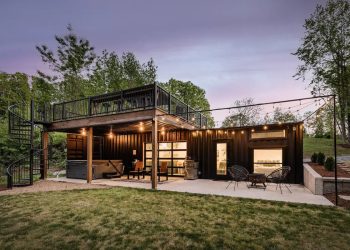Shipping containers, those ubiquitous steel boxes designed for transporting goods across oceans, have found a new purpose as the building blocks for innovative homes.
Typically made from durable Corten steel, these containers are renowned for their ability to endure harsh conditions during transit, offering a lifespan of approximately 25 years.
They come in standard sizes like 8’x20’ or 8’x40’, making them versatile for various construction projects beyond shipping.
Pros of Shipping Container Homes
1. Durability and Strength
Constructed from tough Corten steel, shipping containers are built to withstand extreme weather conditions and rigorous transportation environments.
This inherent strength makes them a reliable choice for permanent structures, offering security and longevity comparable to those of traditional housing materials.
2. Fast Construction
Compared to conventional homes, shipping container homes can be assembled much quicker.
The containers themselves serve as the foundational structure, significantly reducing the time needed for initial construction.
Modifications for livability, such as insulation and interior fittings, are streamlined, speeding up the overall building process.

3. Mobility
One unique advantage of container homes is their portability.
These homes can be transported intact to new locations, offering flexibility that traditional homes cannot match.
Whether relocating due to work or lifestyle changes, container homes can be disassembled and moved with relative ease, provided proper logistical considerations for utilities and site preparation.
4. Lower Cost to Build
Building a shipping container home tends to be more cost-effective than constructing a traditional wood or concrete frame house.
The reduced material and labor requirements, coupled with the reuse of containers, result in significant savings.
Basic container homes can be constructed for as little as $25,000 to $40,000, depending on size and customization, offering an affordable housing option in various economic landscapes.
5. Unique Designs
Container homes lend themselves to creative and innovative design possibilities.
The industrial aesthetic of Corten steel containers allows for architectural freedom not constrained by traditional building methods.
Homeowners can personalize their living space with unique layouts and configurations, embracing a modern and minimalist design ethos that appeals to contemporary tastes.

Cons of Building a Shipping Container Home
Despite their many advantages, shipping container homes present challenges that potential builders should consider.

1. Limited Supply
The COVID-19 pandemic disrupted global supply chains, affecting the availability of new shipping containers.
This scarcity has driven up prices and extended lead times for acquiring containers suitable for residential construction.
Additionally, used containers may come with structural wear or chemical treatments that require remediation, adding complexity and cost to the project.
2. Limited Space
While containers offer a compact building footprint, their standard dimensions limit interior space compared to conventional homes.
Single containers provide approximately 160 to 320 square feet, necessitating creative solutions for maximizing living areas.
Combining multiple containers increases space but escalates construction costs and logistical challenges.
3. High Temperatures
Steel containers can absorb heat, making them susceptible to high temperatures without proper insulation and ventilation.
In warmer climates, additional measures like insulation, ventilation systems, and air conditioning are essential to maintain comfortable indoor environments.
These modifications add expense and reduce available interior space, complicating design and construction plans.
4. Possible Health Hazards
Used containers may contain residual chemicals from cargo transportation, posing health risks if not properly mitigated.
To ensure safety, new containers or those certified free from harmful chemicals are recommended for residential use.
Proper ventilation and insulation techniques can minimize exposure to potential contaminants, safeguarding occupants’ health and well-being.
5. Zoning and Permits
Due to their non-traditional nature, container homes may encounter zoning restrictions and permit challenges in some jurisdictions.
Municipal regulations often require adherence to specific building codes, energy efficiency standards, and emergency access provisions, complicating approval processes.
Potential builders should consult local authorities and engage professionals experienced in container home construction to navigate regulatory requirements effectively.
6. Construction Challenges
Adapting shipping containers into habitable spaces presents unique construction challenges.
Unlike conventional building materials, steel containers require cutting and welding for door and window installations, plumbing integration, and interior layout adjustments.
Addressing structural integrity, weatherproofing, and rust prevention demands specialized skills and expertise, increasing project complexity and potential costs.
Where to Start
For those intrigued by the prospect of a shipping container home, numerous companies offer new and used containers suitable for conversion.
Companies like BigSteelBox provide containers and basic modifications such as electrical installations and insulation, facilitating customization according to individual project needs.
While they do not build container homes outright, they support DIY enthusiasts and contractors in realizing their container home dreams.

Summary
In summary, shipping container homes represent a modern approach to sustainable, cost-effective housing solutions.
With their durability, mobility, and unique design potential, these homes appeal to individuals seeking innovative living spaces amidst evolving societal and environmental challenges.
However, prospective builders must weigh the benefits against the complexities and considerations inherent in container home construction, ensuring informed decisions and successful project outcomes.
Whether as a primary residence, vacation retreat, or investment property, container homes offer a compelling alternative for contemporary living aspirations.












